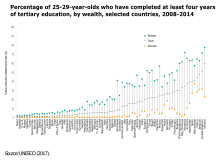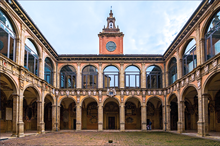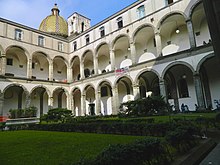
A | B | C | D | E | F | G | H | CH | I | J | K | L | M | N | O | P | Q | R | S | T | U | V | W | X | Y | Z | 0 | 1 | 2 | 3 | 4 | 5 | 6 | 7 | 8 | 9
The examples and perspective in this article may not represent a worldwide view of the subject. (April 2018) |

Tertiary education, also referred to as third-level, third-stage or post-secondary education, is the educational level following the completion of secondary education. The World Bank, for example, defines tertiary education as including universities as well as trade schools and colleges.[1] Higher education is taken to include undergraduate and postgraduate education, while vocational education beyond secondary education is known as further education in the United Kingdom, or included under the category of continuing education in the United States.
Tertiary education generally culminates in the receipt of certificates, diplomas, or academic degrees. Higher education represents levels 5, 6, 7, and 8 of the 2011 version of the International Standard Classification of Education structure. Tertiary education at a nondegree level is sometimes referred to as further education or continuing education as distinct from higher education.
UNESCO stated that tertiary education focuses on learning endeavors in specialized fields. It includes academic and higher vocational education.[2]
The World Bank's 2019 World Development Report on the future of work[3] argues that given the future of work and the increasing role of technology in value chains, tertiary education becomes even more relevant for workers to compete in the labor market.
Definition

Higher education, also called post-secondary education, third-level or tertiary education, is an optional final stage of formal learning that occurs after completion of secondary education. This consists of universities, colleges and polytechnics that offer formal degrees beyond high school or secondary school education.
The International Standard Classification of Education in 1997 initially classified all tertiary education together in the 1997 version of its schema. They were referred to as level 5 and doctoral studies at level 6. In 2011, this was refined and expanded in the 2011 version of the structure. Higher education at undergraduate level, masters and doctoral level became levels 6, 7, and 8. Nondegree level tertiary education, sometimes referred to as further education or continuing education was reordered as level 4, with level 5 for some higher courses.[4]
In the days when few pupils progressed beyond primary education or basic education, the term "higher education" was often used to refer to secondary education, which can create some confusion.[note 1] This is the origin of the term high school for various schools for children between the ages of 14 and 18 (United States) or 11 and 18 (United Kingdom and Australia).[5]
Global progress

Globally, the gross enrollment ratio in tertiary education increased from 19% in 2000 to 38% in 2017, with the female enrollment ratio exceeding the male ratio by 4 percentage points.[6]
The tertiary gross enrollment ratio ranges from 9% in low-income countries to 77% in high-income countries, where, after rapid growth in the 2000s, reached a plateau in the 2010s.[6]
Between now and 2030, the biggest increase in tertiary enrollment ratios is expected in middle-income countries, where it will reach 52%. Sustainable Development Goal 4 (SDG 4) commits countries to providing lifelong learning opportunities for all, including tertiary education.[6]
This commitment is monitored through the global indicator for target 4.3 in the sustainable development goal 4 (SDG 4), which measures the participation rate of youth and adults in formal and non-formal education and training in the previous 12 months, whether for work or non-work purposes.[6]
The right of access to higher education
The right of access to higher education is mentioned in a number of international human rights instruments. The UN International Covenant on Economic, Social and Cultural Rights of 1966 declares, in Article 13, that "higher education shall be made equally accessible to all, on the basis of capacity, by every appropriate means, and in particular by the progressive introduction of free education".[7] In Europe, Article 2 of the First Protocol to the European Convention on Human Rights, adopted in 1950, obliges all signatory parties to guarantee the right to education.[8]
Criticism
In 1994, the UNESCO Salamanca Statement called on the international community to endorse the approach of inclusive education, including at the tertiary level. Since this time the world has witnessed the global massification of tertiary education, yet this explosion of facilities and enrollment has largely entrenched and exacerbated the exclusion of people with disabilities. This is particularly the case in low- and middle-income contexts, where university completion rates for students with disabilities are much lower compared to completion rates of students without disabilities.[9]
Some tertiary schools have been criticized as having permitted or actively encouraged grade inflation.[10][11] In addition, certain scholars contend that the supply of graduates in some fields of study is exceeding the demand for their skills, aggravating graduate unemployment, underemployment and credentialism.[12][13]
Influence on views
Graduates of tertiary education are likely to have different worldviews and moral values than non-graduates. Research indicates that graduates are more likely to have libertarian principles with less adherence to social hierarchies. Graduates are also more likely to embrace cultural and ethnic diversity and express more positive views towards minority groups. For international relationships, graduates are more likely to favor openness, supporting policies like free trade, open borders, the European Union, and more liberal policies regarding international migration.[14]
Providers

In the U.S., higher education is provided by universities, academies, colleges, seminaries, conservatories, and institutes of technology, and certain college-level institutions, including vocational schools, universities of applied sciences, trade schools, and other career-based colleges that award degrees. Tertiary education at a nondegree level is sometimes referred to as further education or continuing education as distinct from higher education.[15][16]
Higher education includes teaching, research, exacting applied work, as exists in medical schools and dental schools, and social services activities of universities.[17]
Within the realm of teaching, it includes both the undergraduate level, and beyond that, graduate-level (or postgraduate level). The latter level of education is often referred to as graduate school, especially in North America. In addition to the skills that are specific to any particular degree, potential employers in any profession are looking for evidence of critical thinking and analytical reasoning skills, teamworking skills, information literacy, ethical judgment, decision-making skills, fluency in speaking and writing, problem solving skills, and a wide knowledge of liberal arts and sciences.[18]
Recognition of studies
The Lisbon Recognition Convention stipulates that degrees and periods of study must be recognised in all of the Signatory Parties of the convention.[19]
History
| ||||
| House of Life "library" in hieroglyphs | ||||
|---|---|---|---|---|


The oldest known institutions of higher education are credited to Dynastic Egypt, with Pr-Anx (houses of life) built as libraries and scriptoriums, containing works on law, architecture, mathematics, and medicine, and involved in the training of "swnw" and "swnwt" (male and female doctors); extant Egyptian papyri from the 3rd millennia BC are in several collections.[22]
In the Greek world, Plato's Academy (c. 387 - 86 BC), Aristotle's Lyceum (c. 334 - 86 BC) and other philosophical-mathematical schools became models for other establishments, particularly in Alexandria of Egypt, under the Ptolemies.
In South Asia, the city of Taxila[when?], later the great Buddhist monastery of Nalanda (c. 427 - 1197 CE), attracted students and professors even from distant regions.[23]
In China, the Han dynasty established chairs to teach the Five Confucean Classics, in the Grand School, Taixue (c. 3 - 1905 CE), to train cadres for the imperial administration.[24][25] All these higher-learning institutions became models for other schools within their sphere of cultural influence.[26]
In 425 CE, the Byzantine emperor Theodosius II innovated as he established the Pandidakterion, with a faculty of 31 professors, to train public servants. In the 7th and 8th centuries, "cathedral schools" were created in Western Europe. Meanwhile, the first Medresahs were founded in the Moslem empire – initially mere primary schools in the premises of major mosques, which gradually evolved toward secondary, later higher education. However high the intellectual level of these schools could be, it would be anachronistic to call them "universities". Their organization and purposes were markedly different from the corporations of students and teachers, independent from both the Church and the State, which established themselves from the 12th century in Western Europe as Universitas Studiorum.[citation needed]
According to UNESCO and Guinness World Records, the University of al-Qarawiyyin in Fez, Morocco is the oldest existing continually operating higher educational institution in the world.[27][28] and is occasionally referred to as the oldest university by scholars.[29] Undoubtedly, there are older institutions of higher education, for example, the University of Ez-Zitouna in Montfleury, Tunis, was first established in 737. The University of Bologna, Italy, founded in 1088, is the world's oldest university in continuous operation,[30][31][32][33][34] and the first university in the sense of a higher-learning and degree-awarding institute, as the word universitas was coined at its foundation.[33][30][31][32]
20th century
Since World War II, developed and many developing countries have increased the participation of the age group who mostly studies higher education from the elite rate, of up to 15 per cent, to the mass rate of 16 to 50 per cent.[35][36] In many developed countries, participation in higher education has continued to increase towards universal or, what Trow later called, open access, where over half of the relevant age group participate in higher education.[37] Higher education is important to national economies, both as an industry, in its own right, and as a source of trained and educated personnel for the rest of the economy. College educated workers have commanded a measurable wage premium and are much less likely to become unemployed than less educated workers.[38][39]
21st century
In recent years, universities have been criticized for permitting or actively encouraging grade inflation.[40][41] Widening participation can increase the supply of graduates in individual fields of study over the demand for their skills, aggravating graduate unemployment, underemployment, overqualification and educational inflation.[42][43] Some commentators have suggested that the impact of the COVID-19 pandemic on education is rapidly making certain aspects of the traditional higher education system obsolete.[44] The involvement and funding by foreign regimes in higher education in the US and Europe raised concerns regarding the erosion of democratic norms and hate speech on campuses.[45][better source needed][46]
Statistics
The total expenditure on tertiary education (ISCED levels 5 to 8) as a percentage of GDP for individual countries is shown in the following table.
| Country | Tertiary Education expenditure as % of GDP 2020[47] |
|---|---|
| 1.9 | |
| 1.8 | |
| 1.6 | |
| 1.2 | |
| 2.4 | |
| 2.7 | |
| 1.5 | |
| 1.6 | |
| 1.2 | |
| 1.1 | |
| 1.9 | |
| 1.5 | |
| 1.6 | |
| 1.6 | |
| 1.3 | |
| 0.9 | |
| 0.9 | |
| 1.4 | |
| 0.8 | |
| 1.4 | |
| 1.0 | |
| 1.4 | |
| 1.4 | |
| 1.2 | |
| 0.5 | |
| 1.2 | |
| 1.8 | |
| 1.6 | |
| 2.0 | |
| 1.3 | |
| 1.3 | |
| 0.8 | |
| 1.1 | |
| 1.2 | |
| 1.5 | |
| 1.5 | |
| 1.6 | |
| 1.5 | |
| 1.5 | |
| 2.5 |
The percentage of adults who have attained individual tertiary education levels by country is shown in the following table.
| Country | Ages 25–64: % attaining a tertiary degree course equivalent to at least:[48] | |||
|---|---|---|---|---|
| Any tertiary | Bachelor's | Master's | Doctoral | |
| 24.8 | 1.4 | |||
| 51.5 | 39.4 | 10.9 | 1.9 | |
| 35.6 | 20.4 | 14.8 | 1.2 | |
| 45.8 | 45.0 | 20.1 | 1.1 | |
| 21.0 | 21.0 | 1.0 | 0.3 | |
| 29.8 | 29.8 | 20.4 | 0.3 | |
| 62.7 | ||||
| 31.4 | ||||
| 18.5 | ||||
| 28.3 | ||||
| 25.3 | ||||
| 26.7 | 26.5 | 19.7 | 0.7 | |
| 42.1 | 37.0 | 16.3 | 1.5 | |
| 42.1 | 36.5 | 21.8 | 0.8 | |
| 42.6 | 35.1 | 17.3 | 1.3 | |
| 41.6 | 27.2 | 15.2 | 1.0 | |
| 32.5 | 31.9 | 13.6 | 1.9 | |
| 35.1 | 34.7 | 9.3 | 0.9 | |
| 29.4 | 28.5 | 13.9 | 0.5 | |
| 12.9 | 12.9 | 3.4 | 3.4 | |
| 13.1 | 10.3 | 0.8 | 0.0 | |
| 43.6 | 39.4 | 18.1 | 1.2 | |
| 54.4 | 44.3 | 16.6 | 1.7 | |
| 50.6 | 39.6 | 15.2 | 1.2 | |
| 20.3 | 20.2 | 14.6 | 0.6 | |
| 56.1 | ||||
| 39.5 | 35.1 | 18.4 | 0.4 | |
| 46.5 | 46.5 | 16.5 | 0.8 | |
| 51.5 | 46.6 | 31.4 | 2.9 | |
| 20.6 | 20.1 | Zdroj:https://en.wikipedia.org?pojem=Postsecondary_education|||
